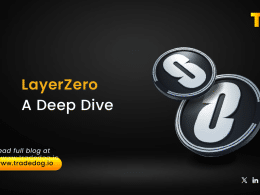Centralized Finance-
You Have internet? Good! But hey, you have to go through a stringent process of verifications and laws before you can use our financial services.
Decentralized Finance-
You have internet? Welcome aboard and start interacting. Period!
The long-existing economic imbalance due to traditional monetary policies paved the way for digital and decentralized assets which then yielded the Decentralized finance. Being centralized, the traditional space of borrowing and lending has been a no-go for most of the people out there. Asking for a loan is gets really impossible without going through a centralised party. What’s centralized will always be that way with little to no room for correction and expansion.
Decentralized Finance, to the contrary, is the much-needed reform for individuals who are concerned for their personal data, ownership, and third party-free monetary services. Billions of dollars locked into pools, continuous development and a frenzy of protocol appearance have made DeFi the next big frontier for digital finance.
Although CeFi and DeFi both equally provide crypto financial services to participants, DeFi being decentralized has an upper edge here. The newfound possibilities in Decentralized Finance such as personalization, interaction with different protocols, token swaps and sifting through the best rate of interest have started attracting huge eyeballs from all walks of life.
How is DeFi different from CeFi?

CeFi- Manages your transactions and money being an intermediary (You trust the bank or the company)
DeFi- Trustless mechanism that eliminates intermediaries and empowers the technology to manage activity, transactions and deals. (You trust the protocol)
In the earlier blogs, we mentioned high-performance DeFi protocols that pose striking features. DeFi’s sole competitor, the Centralised Finance offers its own perks and benefits to its users. Centralized Finance is a custodial framework for lending and borrowing where it’s users can enjoy risk-transference due to the lender bearing custody.
DeFi’s advantage is its non-custodial behaviour and borrows CeFi’s promise of asset safety, security returns but adds intuitive interfaces and highly-sophisticated protocols working under the hood as its own perks. But DeFi’s underlying risks of bugs and weak codes can spell disaster for the investors and liquidity. Since non-custodial means the user is responsible for his own risk, Decentralized Finance can be quite daunting, to begin with. Centralised finance, on the contrary, is boring for the nerdy, and DeFi puts forth the ability to audit, engage with different protocols, stake collaterals, earn passive income and much more.

CeFi’s Drawbacks:
Prone to hacking
Centralised systems have always been the target of hackers and when high liquidity is concerned, it gets easy to exploit code and make some easy money.
DeFi’s Drawbacks:
Prone to Protocol Bugs
Decentralized Finance operates on handwritten codes. Despite being autonomous, they can, however, falter at some moment and drill a hole into the user’s wallets who were enjoying their returns by contributing liquidity in a pool. A pool can lose its funds in an event of a bug making a mistake. The most notable Opyn bug can be viewed here

Let us look at the major advantages and disadvantages of Decentralized Finance
Accessibility
DeFi offers financial services with just one click on your smartphone. With so many protocols to choose from, users can unlock a universe of options to leverage the full potential of the DeFi ecosystem.
Autonomy
There is no central party claiming dominion over your funds such as freezing your account, seize your assets or block transactions The assets you own in the DeFi space are only yours to claim.
Tradability
The most notable DeFi advantage is that enables its users to trade more efficiently through synthetic products by purchasing call and put options rather than committing the entire value of an investment. This way investors can create multiple investment vehicles in different assets and access this ecosystem from anywhere in the world. Synthetic products are very beneficial for the investors as they can lower funding costs, inject more liquidity into the market and open wider market access through a combination of instruments and derivatives.
Transparency
Users have access to publicly available DeFi data that enables them to have a transparent outlook on what’s really happening int the ecosystem. One can check the DeFi reserves at any given moment and sift through different loan rates as an active DeFi participant.
Open Source
All protocols on DeFi are open source which means that anyone can come up and develop a new financial product on top of the underlying technology and foster a new ecosystem altogether.
Fees
Near-zero fees and relatively faster transactions create market efficiencies and enable participation of a broader userbase.

Since Maker is ruling over DeFi right now, it can remove the hassle of volatility due to its DSR and the use of its stablecoin Dai. The appearance of more stablecoins-backed financial service can completely obliterate the centralized lending space with their price that always clings to the $1 mark.
Defi has enabled the most practical implementation of smart contracts in an attempt to create a universe of Lego dapps that can foster many other capabilities. The DeFi macrocosm comprises Collateralized positions, credit and insurance protocols, Decentralised exchanges, derivatives, payment channels, stablecoins, forecast markets, and much more. Despite it being at the epicentre of interest and the fact that it opens access to a wider marketplace, it is critical to outline that DeFi comes with some drawbacks too:
- Low Liquidity
- Risks
- Capital inefficiencies
- UI, UX is tough for newbies
- Unregulated
Risk in DeFi can be classified into three categories:
Financial, Technical, and Procedural.
- Financial Risk involves the comparison of risk and rewards with the investment opportunity with the goal of constructing a success portfolio with an individual or an organization’s tolerance for risk.
- Technical Risk means evaluating potential vulnerabilities in the hardware and software behind a product or service.
- Procedural Risk is something in which users might be manipulated into using the product in ways that could compromise their security.
The only way you can take advantage of DeFi protocols is to spend a substantial amount of research time to narrow down your search to promising projects. TradeDog will continue to post insightful reports on the most promising deFi projects for perusal so that interested parties can engage with the chosen startups that are duly vetted and trustworthy.
Users should not engage with any investment until they have properly researched the intricacies of the project’s ecosystem. Governance, market sentiments, exchange listing, roadmaps, etc. are some of the crucial aspects of a duly vetted project. TradeDog research content consists of ripe market intelligence as general guidelines, but users should spend some time delving deeper into the statistics themselves for a comprehensive understanding of the factors at play.
Share the article across your social channels if you like
Stay in the know by following our social channels here
Website Telegram Twitter Facebook Pinterest Youtube Instagram







